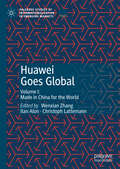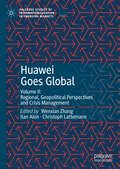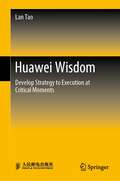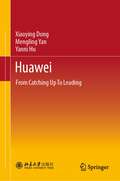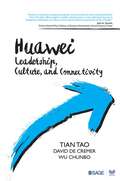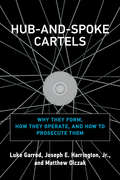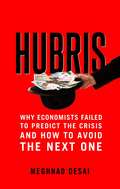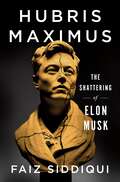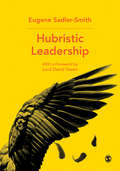- Table View
- List View
Howard Schultz: Building Starbucks Community (A)
by Andrew N. Mclean William W. GeorgeIn 2006, Howard Schultz reflects on his leadership at Starbucks in light of its continued growth plans. Provides information on the leadership development of the protagonist, tracing his youth and education, his early business career, his acquisition of Starbucks, and its subsequent massive growth. Raises questions about leadership styles, the role of a self-authored life story in leadership, and the qualities that attract, retain, and deploy complementary management talent.
Howard Schultz: Building Starbucks Community (B)
by William W. George Lance PierceSupplements the (A) case.
Hrad Technika
by Bradley R. Staats David M. UptonExamines a struggling IT outsourcing project from the perspective of the IT services provider--Hrad Technika. When used in conjunction with Tegan c.c.c. (9-609-038), it provides an opportunity to see both sides of the issue. When Hrad enters into a contract to create a new accounts payable system for Welsh toy distributor, Tegan, the outsourcing firm from the Czech Republic views the project as another step in its progression towards delivering higher value services. Unfortunately the project goes poorly, and Hrad is left with the decision of how to rescue the relationship and avoid a similar problem in the future. The case allows the examination of how to manage an outsourcing project and permits a general discussion about IT outsourcing.
Huawei Goes Global: Volume I: Made in China for the World (Palgrave Studies of Internationalization in Emerging Markets)
by Ilan Alon Christoph Lattemann Wenxian ZhangHuawei Goes Global provides a much-needed, comprehensive, and scholarly examination of the business environment and the striving global operations of China’s technology giant. With theoretical research, case studies, data analysis, and empirical studies, this two-volume work tells a fascinating story of internationalization in an emerging economy. As one of the most powerful Chinese companies in the global economy, the largest global telecommunications-equipment producer and a leading consumer-electronics manufacturer, Huawei is a great example of the globalization of the Chinese enterprises in the twenty-first century.In Volume I, scholars critically examine the rise of Huawei as a Chinese global enterprise from the political economy and public policy perspectives, as well as Huawei’s development strategies, innovations, and talent management. In Volume II, multiple authors carefully study the growth of Huawei from regional and geopolitical perspectives, and its corporate communication and crisis management. Within the framework of the trade conflicts between China and the US, controversies over economic sanctions, intellectual property disputes, and espionage and cyber security concerns, this groundbreaking work makes an important contribution to both academic literature and the ongoing public discourse on Huawei.Volume II is available here: https://www.palgrave.com/gp/book/9783030475789
Huawei Goes Global: Volume II: Regional, Geopolitical Perspectives and Crisis Management (Palgrave Studies of Internationalization in Emerging Markets)
by Ilan Alon Christoph Lattemann Wenxian ZhangHuawei Goes Global provides a much-needed, comprehensive, and scholarly examination of the business environment and the striving global operations of China’s technology giant. With theoretical research, case studies, data analysis, and empirical studies, this two-volume work tells a fascinating story of internationalization in an emerging economy. As one of the most powerful Chinese companies in the global economy, the largest global telecommunications-equipment producer and a leading consumer-electronics manufacturer, Huawei is a great example of the globalization of the Chinese enterprises in the twenty-first century. In Volume I, scholars critically examine the rise of Huawei as a Chinese global enterprise from the political economy and public policy perspectives, as well as Huawei’s development strategies, innovations, and talent management. In Volume II, multiple authors carefully study the growth of Huawei from regional and geopolitical perspectives, and its corporate communication and crisis management. Within the framework of the trade conflicts between China and the US, controversies over economic sanctions, intellectual-property disputes, and espionage and cyber security concerns, this groundbreaking work makes an important contribution to both academic literature and the ongoing public discourse on Huawei.Volume I is available here: https://www.palgrave.com/gp/book/9783030475635
Huawei Wisdom: Develop Strategy to Execution at Critical Moments
by Lan TaoThis book reviews the three life-and-death crisis moments that Huawei experienced during its growth and the major transformation process triggered by these crises. It describes in detail how Huawei thinks about future strategies at these critical moments and how to implement these strategies during its daily work. This book involves the content of corporate globalization strategy decision making, overseas marketing, change management, etc.This book is suitable for middle and senior managers of the enterprises facing difficulties in product development, market development, and business model transformation, especially in the information and communication industry, manufacturing, etc. And it helps to inspire researchers and students, consultants, and trainers who major in corporate transformation, strategic management, and international marketing.
Huawei: A Global Tech Giant in the Crossfire of a Digital Cold War
by William C. Kirby Billy Chan John P. McHughCase
Huawei: From Catching Up To Leading
by Xiaoying Dong Yanni Hu Mengling YanThrough in-depth case studies, this book seeks to reveal the secret of Huawei's rapid growth. The content of this book is rich and detailed. The authors combine first-hand interview data, including Huawei managers of many functional departments such as research and development, marketing, supply chain management, and human resources, as well as Huawei’s suppliers partners and competitors. This book analyzes the articles and speeches published by Huawei’s leader Ren Zhengfei since 1994 both in the public and internally and reference to various materials about Huawei including employee’s postings in the social media, news reports, research papers, books, etc. The book systematically describes the key elements of Huawei's strategy, corporate culture, organizational capabilities, and R&D innovation system and so on. The book also compared the differences between Huawei and Cisco in many subjects as leadership, culture, organization transformation and management capabilities. For whoever tries to understand Huawei, this book is an excellent reference book. In the companion book Cisco: Integration of Innovation and Operation, the author tells another growth path of technology company in America.
Huawei: Leadership, Culture, and Connectivity
by Tian Tao David De Cremer Wu ChunboThe inspirational business story of Huawei: how to grow from start up to world leader in two decades… With over 170,000 employees in more than 170 countries and regions, serving more than one-third of the world′s population, how does entrepreneur Ren Zhengfei manage a telcoms giant called Huawei? What is the secret to Huawei’s global success? In 1987, a 44-year-old man founded a telecom equipment-trading firm in Shenzhen, China, with start-up capital of $5,000. In 29 years, it grew to become the largest telecoms company in the world. This book goes behind the scenes to explore the story of what Ren Zhengfei did differently, how the company he started reached the top spot, and why Huawei is known as a "collective" and not a private company: Learn how this Chinese start up business became an international success Understand the business strategy, leadership skills and management philosophy of Huawei’s entrepreneurial founder Get tips, inspiration and motivation for your own business start-up. 14 years of meticulous research and 136 senior management and employee interviews reveal how Huawei′s international business success lies in its ability to transform the intellectual elite into a band of soldiers with the same set of values and resolve, while at the same time preventing a culture of subservience. This fascinating story provides a unique glimpse into the machinations of one of the world’s most powerful companies. "The company serves as an example for many Chinese entrepreneurs striving to go global, and also presents valuable lessons for Western companies striving to integrate Eastern and Western values and ways of looking at business." - Co-author David De Cremer, KPMG Professor of Management Studies at Cambridge Judge Business School
Huaxia: Building a U.S.-Style Dairy in China
by Tarun Khanna Nancy Hua Dai Juan MaIn 2015, Charles Shao, chairman of Huaxia, considered the alternatives to ensure sustainable growth of Huaxia and rebuild the overall health of China's dairy industry. He came to China in 2004 and set up Huaxia dairy farm with the goal to build a world-class dairy farm in China. In 2015, Huaxia had three farms in operation with approximately 20,000 cows (including 7,200 milking cows) and a daily production of 220 tons of raw milk. It sold most of its raw milk to top dairy brands in China while selling a small volume of dairy products under its own premium brand Wondermilk. Besides running his own dairy farms, Shao had been providing free training in dairy farm management to industry peers, developing a milk-traceability system, and setting up a consulting firm to offer dairy management services. Should he continue to invest in these initiatives that benefitted the whole industry or focus resources on growing his own business?
Huaxia: Building a U.S.-Style Dairy in China
by Tarun Khanna Nancy Hua Dai Juan MaIn 2015, Charles Shao, chairman of Huaxia, considered the alternatives to ensure sustainable growth of Huaxia and rebuild the overall health of China's dairy industry. He came to China in 2004 and set up Huaxia dairy farm with the goal to build a world-class dairy farm in China. In 2015, Huaxia had three farms in operation with about 20,000 cows (including 7,200 milking cows) and daily production of 220 tons of raw milk. It sold most of its raw milk to top dairy brands in China while selling a small volume of dairy products under its own premium brand Wondermilk. Besides running his own dairy farms, he had been providing free training in dairy farm management to industry peers, developing a milk-traceability system, and set up a consulting firm to offer dairy management services. Should he continue to invest in these initiatives that benefitted the whole industry or focus resources on growing his own business? <p><p> To understand the causes of the milk scandal in China, analyze the economics of Huaxia Dairy Farm, evaluate Huaxia's efforts to build the ecosystem, and discuss the growth alternatives.
Hub and Spoke, HealthCare Global, and Additional Focused Factory Models for Cancer Care
by Regina E. Herzlinger Amit Ghorawat Meera Krishnan Naiyya SaggiThis case compares and contrasts four different models for delivering cancer care in India and the US. Students are asked to select the best model in its alignment with the Six Forces in those two countries and Africa, to which one of the models is considering expansion, and intrinsic business characteristics. The Indian models are all focused factories, but one is a hub and spoke model, with a radiology hub and ambulatory spokes, while the other offers only ambulatory services. The U.S. models are all focused factory hospitals, one academic and the other a private, for-profit firm located on the grounds of teaching hospitals.
Hub-and-Spoke Cartels: Why They Form, How They Operate, and How to Prosecute Them
by Joseph E. Harrington Luke Garrod Matthew OlczakThe first comprehensive economic and legal analysis of hub-and-spoke cartels, with detailed case studies.A cartel forms when competitors conspire to limit competition through coordinated actions. Most cartels are composed exclusively of firms that would otherwise be in competition, but in a hub-and-spoke cartel, those competitors (&“spokes&”) conspire with the assistance of an upstream supplier or a downstream buyer (&“hub&”). This book provides the first comprehensive economic and legal analysis of hub-and-spoke cartels, explaining their formation and how they operate to create and sustain a collusive environment. Sixteen detailed case studies, including cases brought against toy manufacturer Hasbro and the Apple ebook case, illustrate the economic framework and legal strategies discussed. The authors identify three types of hub-and-spoke cartels: when an upstream firm facilitates downstream firms to coordinate on higher prices; when a downstream intermediary facilitates upstream suppliers to coordinate on higher prices; and when a downstream firm facilitates upstream suppliers to exclude a downstream rival. They devote a chapter to each type, discussing the formation, coordination, enforcement, efficacy, and prosecution of these cartels, and consider general lessons that can be drawn from the case studies. Finally, they present strategies for prosecuting hub-and-spoke collusion. The book is written to be accessible to both economists and lawyers, and is intended for both scholars and practitioners.
HubSpot and Motion AI: Chatbot-Enabled CRM
by Jill Avery Thomas SteenburghHubSpot, an inbound marketing, sales, and customer relationship management (CRM) software provider, announced that it had acquired Motion AI, a software platform that enabled companies to easily build and deploy chatbots, fueled by artificial intelligence, to interact with their customers. Before unleashing bot-building technology to its B2B customers, HubSpot first needed to develop some best practices for the use of chatbots for CRM. First, the team had to clearly assess the trade-offs between effectiveness and efficiency associated with the use of bots versus humans to create, nurture, and manage customer relationships. Second, they had to decide to what extent to anthropomorphize the chatbots. How human-like should they be? Was a conversational user interface (UI) the desired solution for B2B CRM or would a stripped down, more functional UI produce more efficiency for the customers who interacted with the bot? Historically, HubSpot had "practiced what it preached," using its own products to build its business. The team had to consider whether to use chatbots to nurture and service its own customer relationships and manage the effectiveness and efficiency of its sales funnel. Currently, a team of chat representatives worked with marketing to qualify and prime prospects for HubSpot's sales team. Could they and should they be replaced with chatbots? Was HubSpot ready for bots to become the face of its brand to its prospective customers?
HubSpot and Motion AI: Chatbot-Enabled CRM
by Jill Avery Thomas SteenburghHubSpot, an inbound marketing, sales, and customer relationship management (CRM) software provider, announced that it had acquired Motion AI, a software platform that enabled companies to easily build and deploy chatbots, fueled by artificial intelligence, to interact with their customers. Before unleashing bot-building technology to its B2B customers, HubSpot first needed to develop some best practices for the use of chatbots for CRM. First, the team had to clearly assess the trade-offs between effectiveness and efficiency associated with the use of bots versus humans to create, nurture, and manage customer relationships. Second, they had to decide to what extent to anthropomorphize the chatbots. How human-like should they be? Was a conversational user interface (UI) the desired solution for B2B CRM or would a stripped down, more functional UI produce more efficiency for the customers who interacted with the bot? Historically, HubSpot had "practiced what it preached," using its own products to build its business. The team had to consider whether to use chatbots to nurture and service its own customer relationships and manage the effectiveness and efficiency of its sales funnel. Currently, a team of chat representatives worked with marketing to qualify and prime prospects for HubSpot's sales team. Could they and should they be replaced with chatbots? Was HubSpot ready for bots to become the face of its brand to its prospective customers?
HubSpot: Inbound Marketing and Web 2.0
by Jill Avery Thomas Steenburgh Naseem DahodThe case 'HubSpot: Inbound Marketing and Web 2.0' introduces the concept of inbound marketing, pulling customer prospects toward a business through the use of Web 2.0 tools and applications like blogging, search engine optimization, and social media. Students follow the growth of HubSpot, an entrepreneurial venture which, in its quest for growth, faces significant challenges including: developing market segmentation and targeting strategies to decide which customer to serve and which to turn away, configuring pricing strategies to align with the value delivery stream customers experience, and determining whether inbound marketing programs can generate enough scale or whether traditional outbound marketing methods need to be employed to accelerate growth.
Hubble Contact Lenses: Data Driven Direct-to-Consumer Marketing
by Jill Avery Ayelet IsraeliAs its Series A extension round approaches, the founders of Hubble, a subscription-based, social media fueled, direct-to-consumer (DTC) brand of contact lenses, are reflecting on the marketing strategies that have taken them to a valuation of $200 million and debating changes to them that will allow them to grow their Business. Ensuring that their marketing dollars were being spent efficiently was critical to the data-driven management team and proving to be complicated as the company moved spending from digital marketing to offline media, which made attribution modeling more difficult. Decisions pertaining to product extensions, channel expansion beyond DTC e-commerce, and geographic expansion were also on the table to prove that Hubble's customer value proposition and operations could profitably scale.
Hubble Contact Lenses: Data Driven Direct-to-Consumer Marketing
by Jill Avery Ayelet IsraeliAs its Series A extension round approaches, the founders of Hubble, a subscription-based, social media fueled, direct-to-consumer (DTC) brand of contact lenses, are reflecting on the marketing strategies that have taken them to a valuation of $200 million and debating changes to them that will allow them to grow their Business. Ensuring that their marketing dollars were being spent efficiently was critical to the data-driven management team and proving to be complicated as the company moved spending from digital marketing to offline media, which made attribution modeling more difficult. Decisions pertaining to product extensions, channel expansion beyond DTC e-commerce, and geographic expansion were also on the table to prove that Hubble's customer value proposition and operations could profitably scale.
Hubei Lantian (A)
by David F. Hawkins Michael Shih-ta Chen Nancy Hua DaiEmily Wang, an analyst with Future Securities, a Shanghai-based investment firm, is given the task of making stock purchase recommendations to her supervisor from a number of Chinese common stocks. One stock in particular, Hubei Lantian Co., Ltd. (Hubei Lantian), caught Emily's attention as a likely purchase recommendation. Before making her recommendation decision, Emily felt she needed to look deeper into the company's operating performance and financial condition. To this end, Emily performed a financial ratio analysis comparison of Hubei Lantian's financial ratios to those of selected peer companies. Hubei Lantian's major revenue sources were aquatic products (fish, ducks) and beverages (lotus root juice, mineral water). Guided by these revenue sources, Emily selected the financial statements of four companies in the fishery industry and three companies in the food and beverage industry to perform a peer company comparative financial ratio analysis. The case reproduces the individual company financial ratios Emily computed for her comparative ratio analysis. The student's task is to use these ratios and whatever insights they can develop from the case data to assess Hubei Lantian's individual and comparative performance, financial condition, and quality of earnings. In addition, the case assignment asks students to suggest possible lines of inquiry Emily might pursue if given the opportunity to conduct field research. At the end of the class, students are asked to make a stock recommendation.
Hubris
by Meghnad DesaiThe failure of economists to anticipate the global financial crisis and mitigate the impact of the ensuing recession has spurred a public outcry. Economists are under fire, but questions concerning exactly how to redeem the discipline remain unanswered. In this provocative book, renowned economist Meghnad Desai investigates the evolution of economics and maps its trajectory against the occurrence of major political events to provide a definitive answer. Desai underscores the contribution of hubris to economists' calamitous lack of foresight, and he makes a persuasive case for the profession to re-engage with the history of economic thought. He dismisses the notion that one over-arching paradigm can resolve all economic eventualities while urging that an array of already-available theories and approaches be considered anew for the insights they may provide toward preventing future economic catastrophes. With an accessible style and keen common sense, Desai offers a fresh perspective on some of the most important economic issues of our time. "
Hubris Maximus: The Shattering of Elon Musk
by Faiz SiddiquiThe rise, fall, and revival of the Caesar of Silicon Valley. Elon Musk has cast himself as the savior of humanity, an altruistic force whose fortune is tied to noble pursuits from halting our dependence on fossil fuels to colonizing Mars. Once frequently heralded as a modern-day Edison, Musk has taken up a new place in the public consciousness with his growing desire to disrupt not just the automotive and space industries but the policies that shape our nation, placing him at the center of America’s most complex undertakings in manufacturing, politics, and defense and technology, even as his increasingly erratic personal behavior has raised questions about his stability and judgement. Musk famously leads his companies from a bully pulpit, eroding guardrails and cutting through red tape whenever possible with little regard for the fallout as long as it serves his larger goals. Many in his orbit have seen their lives upended or their careers throttled by believing in his utopian vision. As the scale of the wagers he makes with his fortune and concerns about his credibility have grown in recent years, he alternately seems to be in complete command or on the verge of a meltdown. Yet in the long run, he has only become wealthier, and now the stakes have risen. Thanks to astute political maneuvering, Musk is no longer limited to gambling with a company’s bottom line or the livelihoods of his workers; he is poised to apply his uncompromising approach to business to the foundational rules and regulations that hold our society together. At a moment when America’s tech gods are more influential than ever, Hubris Maximus is a cautionary tale about the pitfalls of lionizing magnetic leaders. Washington Post journalist Faiz Siddiqui offers a gripping, detailed portrait of a singularly messy and lucrative period in Musk’s career, as well as a case study in the power of using one’s platform to shape the public narrative in a world that can’t turn away from its screens.
Hubristic Leadership
by Eugene Sadler-SmithInvestigating the societal, economic, financial and reputational costs of hubristic leadership, with insights into the characteristics and causes of this phenomenon, and recommended safeguards to avoid hubris from happening in the first place. As research into hubristic leadership becomes increasingly popular following recent political developments, the book adopts an inter-disciplinary approach to investigating this form of leadership. Outlining what causes hubristic leadership in the first place, the author looks at how it’s potentially destructive consequences can be anticipated and avoided through an informed stance of moderation, critical analysis and reflexivity. Examples are drawn from business and politics including the Lehmann Brothers, BP and Deepwater Horizon, Blair and Bush in the Iraq Invasion, NASA, and Donald Trump. Ideal reading for undergraduate and postgraduate students in business and management, leadership, and organizational behaviour. Check out the Hubris Hub for further information on hubristic leadership, including a regularly updated blog written by author Eugene Sadler-Smith.
Hubristic Leadership
by Eugene Sadler-SmithInvestigating the societal, economic, financial and reputational costs of hubristic leadership, with insights into the characteristics and causes of this phenomenon, and recommended safeguards to avoid hubris from happening in the first place. As research into hubristic leadership becomes increasingly popular following recent political developments, the book adopts an inter-disciplinary approach to investigating this form of leadership. Outlining what causes hubristic leadership in the first place, the author looks at how it’s potentially destructive consequences can be anticipated and avoided through an informed stance of moderation, critical analysis and reflexivity. Examples are drawn from business and politics including the Lehmann Brothers, BP and Deepwater Horizon, Blair and Bush in the Iraq Invasion, NASA, and Donald Trump. Ideal reading for undergraduate and postgraduate students in business and management, leadership, and organizational behaviour. Check out the Hubris Hub for further information on hubristic leadership, including a regularly updated blog written by author Eugene Sadler-Smith.

